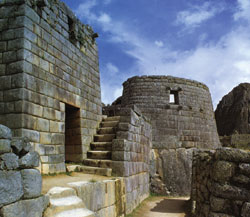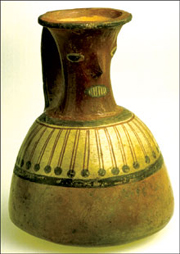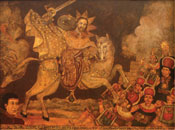Machu
Picchu
Unveiling the Mystery of the Incas
By Robert J. Gangewere
In 1911, the lost Inca city of Machu Picchu was discovered
by chance by mountaineer and archaeologist Hiram
Bingham. He was in Peru with three companions to
climb the highest
mountains of the region, and he had been impressed
by Inca ruins two years earlier when he visited
South America on a Yale University tour of ceremonial
sites.
A wealthy explorer, he was fascinated by the
idea of Peru’s legendary “lost city,” which
had disappeared with the Inca civilization in
the 1500s. Hiram
Bingham (1875-1956) came upon Machu Picchu when he
was exploring the valley of the Urubamba River,
about a three-day hike from Cuzco, the ancient capitol
city of the Incas. By chance in 1911, the Peruvian
government had blasted a rough trail through the
river gorges to make a new road that would aid in transporting
products such as cocoa, sugar, and rubber from the
Amazon. Bingham was one of the first to use the road
in his search for lost Inca sites. As a climber,
he
decided at one point to scramble up through the dense
rainforest around him with a companion and an Indian
guide, and he unexpectedly arrived at mid-day at
a high Indian farm 1,000 feet above the plunging river.
Two native farmers working the farm were surprised
to see them, and offered them water and sweet potatoes.
They also told Bingham that there were ancient ruins,
in the common expression, “a little further
on.”
 Explorer
Hiram Bingham during a 1912 expedition to Machu Picchu. Explorer
Hiram Bingham during a 1912 expedition to Machu Picchu.
Credit: Peabody Museum of Natural History, Yale University
With a 10-year old Indian boy as a guide,
Bingham kept on climbing. He suddenly came upon “a
magnificent flight of stone agricultural terraces,
rising 1,000
feet up the mountainside.” He climbed upwards
for an hour more and found himself finally in a
deep forest above these terraces, surrounded by
stone
buildings, including a temple made of granite blocks
that had
been cut with the amazing precision of Inca stonemasons.
Bingham wrote:“ Surprise followed surprise
in bewildering succession. I climbed a marvelous
stairway of granite blocks,
walked along a pampa where the Indians had a
small vegetable
garden, and came to a clearing in which were
two of the finest structures I had ever seen.
Not only
were
there blocks of beautifully grained white granite,
the ashlars [squared blocks] were of Cyclopean
size, some 10 feet in length and higher than
a man. I was
spellbound.” There in the cloud forest of
the Andes mountains, 2,000 feet above the roaring
river below, Bingham
believed
he had stumbled upon the fabled “Lost City
of the Incas.” But was it really that?
The Riddle of Macu Picchu
Machu Picchu was an astonishing 20th century archaeological
discovery, but it was also a puzzle. Modern researchers
such as Yale’s Richard L. Burger and Lucy Salazar
(co-curators of Machu Picchu: Unveiling the Mystery
of the Incas) believe that Machu Picchu was a royal
retreat or country palace, used by the great Inca
Emperor Pachacuti and his guests as a place to relax,
feast, hunt, and engage in ritual activities related
to his divine kingship. In modern American terms,
Burger calls it a “Camp David” for the
Inca Sun God and his followers.
For decades, beginning
with Bingham’s theories,
the mystery of the site has provoked various interpretations:
that it was an ancient military stronghold, or that
it was the last holdout of the Incas against the
invading Conquistadors in the 16th century. Some
believed it
was an isolated religious sanctuary where nuns and
priests worshipped the sun.
 Burger and Salazar argue
that it was active for less than 100 years, and
that it was a summer palace for
the Inca elite from Cuzco, the empire's capital.
Situated magnificently in the Peruvian Andes, it
was populated
seasonally by the ruling Inca and several hundred
craftsmen and other servants necessary to carry
on the affairs
of estate and government. Burger and Salazar argue
that it was active for less than 100 years, and
that it was a summer palace for
the Inca elite from Cuzco, the empire's capital.
Situated magnificently in the Peruvian Andes, it
was populated
seasonally by the ruling Inca and several hundred
craftsmen and other servants necessary to carry
on the affairs
of estate and government.
Many of the buildings
in Mach Picchu show
signs of having religious or
spiritual significance.
Salazar believes the
royal estate was built by the first imperial ruler
of the Inca Empire, Pachacuti,
about 1460. Machu Picchu is so close to the
capitol of the empire, Cuzco, that Burger says, "Pachacuti
may well have picked out the site simply because
it was so beautiful. The Inca were connoisseurs
of highland
panoramas, and they had an aesthetic about stonework
and mountain views."
“
Inca” as a word stands for the ruling elite
and their ethnic group. Thus, the Incas, who
ruled an empire
of many different clans and ethnic groups, would
periodically make their presence known by taking
up residence at
a series of royal estates. At Machu Picchu the
population may have been varied in reflecting
the complexity of
the Inca empire. The place was more like a melting
pot of the Inca empire, more like New York than
an isolated rural village in Peru. People living
there
could have come from all over the empire, from
different ethnic groups, and would have spoken
different languages.
But their common purpose for coming together
would have been to serve their emperor, the divine
King. Archaeologists now believe that many of
the buildings
at Machu Picchu show signs of having had religious
and spiritual significance. There are shrines,
royal houses, and a cloister for women. In
Inca tradition,
there were women whose sacred task was serving
the divine King, and who engaged in weaving
and cooking
for the sun. One series of erect monolithic
stones can be interpreted as resting places where the
sun seemed to pause in its course across the
sky. Another
building could have been the place where the
Inca ruler entered to speak directly to the
sun,
and
from which
he returned to tell the people what the sun
had said.
Inca religion was full of natural shrines
with magical importance, places where the sun and
the stars could
be worshipped, and where the ancestors were
venerated. Machu Picchu’s dramatic isolation
high on a granite spine of rock suggests spiritual
meaning. The Inca
were astronomers, and the divine King himself
wore a tunic with rows of complex geometric
motifs, suggesting
the forces of energy that interacted between
heaven and earth.
Experiencing the Exhibition
 Inca
bottle found at Machu Picchu. Inca
bottle found at Machu Picchu.
Images courtesy of Peabody Museum of Natural History,
Yale University
When Hiram Bingham supervised the Yale-Peruvian excavations
at the site from 1911 to 1915, he excavated hundreds
of objects that tell the story of everyday Inca life,
and he took almost 1,000 photographs of the site
as he worked on it. By agreement with the Peruvian
government, Bingham sent the 1912 materials back
to the collections of the Peabody Museum at Yale.
Featured in the Machu Picchu exhibit are over 300
objects of gold, silver, ceramic, bone, and textile
from the Peabody collection, just part of the total
of 400 objects from various Inca sites. This is the
most complete presentation of the Inca culture ever
organized, containing the finest surviving examples
of Inca art on loan from Peru, Europe, and other
major U.S. collections.
With the exhibit’s
interactive components, visitors “travel” into
the past, first to Machu Picchu with Hiram Bingham
in 1911, and then further back to the 15th century
when Machu Picchu functioned as an Inca royal estate.
There is a panorama of the high altitude cloud forest
of Peru, a walk along a replica of an ancient Inca
road, and a self-guided interactive tour of the Inca
palace complex, including an Inca burial chamber.
Inside the house of the Inca king is a life-size
mannequin
of the king, wearing gold jewelry and an alpaca tunic
specifically reproduced for the exhibit by craftsmen
in Peru.
The exhibit also draws visitors into the
subjects of archaeological interpretation, how
scientists
explored
the riddle of Machu Picchu’s purpose, and why
the site was abandoned.
The Incas—A Rich Civilization that
Disappeared
The Incas were the Romans of the Andean world—efficient
administrators, excellent soldiers, and fine engineers—but
like other South American people they had no written
language. Their tribal power as an austere mountain
clan developed from the 13th century on, and in the
1450s it dramatically increased under emperor Pachacuti
(the Alexander the Great of the Incas) and his son
Tupac Inca who took a small warlike tribe with loose
control over its neighbors and transformed it into
the center of a huge, stable empire. Under Pachacuti
the Incas exercised control over tribes from the
shores of the Pacific to the headwaters of the Amazon,
some
one-third of the continent. The capital city of Cuzco
was built on a monumental scale as a great fortress,
from which the emperor as the Sun God could exercise
complete control.
A bone shawl pick.
 Pachacuti
and his son Topa created the amazing network of roads,
fortresses and warehouses
that kept newly
conquered tribes under control. The Inca roads
were marvels of engineering, the finest in the world,
and crossed more difficult terrain than Roman
roads. The “beautiful
road” (Capac-ñan) which runs from
Cuzco to Quito, 1500 miles, with a uniform width
of 25
feet, was built of beautifully dovetailed blocks
of stone.
Rivulets of water ran beside most of the roads,
to quench the thirst of travelers. Pachacuti
and his son Topa created the amazing network of roads,
fortresses and warehouses
that kept newly
conquered tribes under control. The Inca roads
were marvels of engineering, the finest in the world,
and crossed more difficult terrain than Roman
roads. The “beautiful
road” (Capac-ñan) which runs from
Cuzco to Quito, 1500 miles, with a uniform width
of 25
feet, was built of beautifully dovetailed blocks
of stone.
Rivulets of water ran beside most of the roads,
to quench the thirst of travelers.
Just as the practical
Romans derived much of their
rich cultural life from Greek and even Egyptian
predecessors, the Incas adopted many aspects
of their own culture
from earlier and artistically rich Andean civilizations.
The first ancient civilizations emerged on the
coast of Peru about 4,000 years ago. With today’s
knowledge, it is absurd to trace Andean civilization
only back
to the Incas, who for only a brief century or
two were able to fuse into one empire a conglomeration
of already
existing tribes and cultures.
Since no people
in South America had yet invented
writing, the Inca tradition of keeping records
was oral, and
professional bards recited the historical events
of the past, being careful to revise history
by omitting details that predated the coming
of the
Incas. Still,
historians now have the impression that the
pragmatic Inca empire at its zenith was like a caring
and
efficient welfare state, focused on the everyday
needs of its
diverse populations. One example would be the
secret drop-off places in Cuzco, where mothers
could leave
unwanted newborn babies, knowing they would
be cared for by state-run orphanages.
How an Inca society
that was so rich and so well advanced in the arts
of civilization could
suddenly
disappear
from the world scene between the 1530s and
1570s is a critical question. The ruined
Inca buildings,
agricultural
terraces for farming, and amazing roads of
stone remained, but the artifacts and the
detailed records of their
way of life took a long time to be discovered
and analyzed.
“Night fell at noon”: The Spanish
Conquest
The central fact governing the disappearance of evidence
about the historic Incas was the Spanish Conquest that
began in the 1530s. Within a few decades, the daily
objects, ancestral materials, and treasures of Inca
civilization were methodically destroyed or removed
by the Conquistadors. After Francisco Pizarro and his
indiscriminate band of soldiers sacked the Inca capital
of Cuzco in 1533, the other major Inca cities were
soon overcome, and the gold and silver treasures of
the empire were collected, melted, and converted into
bars, and sent back to the treasury in Spain. “Whatever
can be burned, is burned; the rest is broken,” reported
one Spanish chronicler. One Inca observation that survived
was, “Night fell at noon.”
 A
17th-century painting depicting the Spanish conquest
of the Incas A
17th-century painting depicting the Spanish conquest
of the Incas
Gold hidden in the national vaults was the economic
foundation of Medieval Europe, and in the 14th and
15th centuries most of it came from the west coast
of Africa. But in the 16th century, South America
presented a new stream of wealth to the mother country,
Spain.
The Conquistadors in the New World not only gathered
up all the precious objects, but they continually
sought something more, the mythic El Dorado—a hoard
of gold at the end of the rainbow—to enrich the
Spanish Crown. The conquest of Montezuma and the Aztecs
in Mexico by Cortez in 1519 had set an example that
a few years later was followed by the Conquistadors
in the Andes. Inca civilization was also ripe for European
exploitation in the early 1500s. A smallpox epidemic
introduced
from Europe had weakened the Andean populations,
killing the last major Inca ruler, and there was a
civil war between two competing contenders for the
throne. It was difficult for Inca clans to unite against
a common enemy.
In addition, the Inca made disastrous
military mistakes. They did not at first retreat
into the mountains
to fight the Spaniards, where they would have had
an advantage, but used clubs and short swords to
fight Conquistadors wearing armor and riding horses
(an animal that had never been seen before). The
Spanish used deadly steel swords, and fired canons
and other firearms. The Incas were slaughtered
by the thousands, and their rulers executed in public.
Soon all the Inca cities had been looted and ruined,
and the ruling class was gone.
Still, there remained a legend, kept alive by the
Spanish chroniclers, of a “lost city” in
the jungle, bypassed by the conquerors, where Inca
cultural materials survived. It was this centuries-old
legend that Hiram Bingham, like many others, was
ready to believe. Machu Picchu, found to be nearly
inaccessible on a mountaintop, seemed to be the
perfect lost city.
Later archaeology and research
in the 20th century
have continued to refine our understanding and
theories about the lost Inca culture. Whether
Richard L. Burger,
director of the Peabody Museum from 1995 through
the end of 2002, and his co-curator Lucy C. Salazar,
have finally solved the mystery of Machu Picchu,
is up to visitors to the exhibit to decide.
Machu Picchu: Unveiling the Mystery of the Incas was
organized by the Yale Peabody Museum of Natural History.
The exhibit is made possible by grants and support
from the National Endowment for the Humanities, the
National Science Foundation, the Connecticut Humanities
Council, The Heritage Mark Foundation, The William
Bingham Foundation, Yale University and The Peruvian
Connection.
After premiering at Yale University, the
exhibit has started a two-year tour of five Museums:
the Natural
History Museum of Los Angeles County, Carnegie
Museum of Natural History, Denver Museum of Nature
and Science,
and Chicago's Field Museum. One other venue is
yet to be named.
Back to Contents
|